PHP is a programming language that has a relatively simple but versatile syntax, making it a great starting point for beginners. However, you might still be overwhelmed by the thought of implementing PHP code for the first time.
Fortunately, there are plenty of free resources you can use to learn PHP. Whether you watch a few YouTube tutorials or take an online course, you can quickly become familiar with this popular programming language.
In this post, we’ll introduce you to PHP and explain the benefits of learning it. Then, we’ll show you some easy ways to get started. Ready to dive in?
An Introduction to PHP
PHP (PHP: Hypertext Preprocessor) is a server-side scripting language used in web development. It’s currently used on 77.6% of websites, including Facebook, Wikipedia, and Instagram:

Like WordPress, PHP is open-source. Originally, it was used simply to build a personal homepage. However, since its creation in 1994, PHP has evolved to accommodate more dynamic websites.
The first thing you need to know about PHP programming is that it happens on the server. When someone tries to visit your website, your server will process its PHP code before sending any information to the browser.
This is what makes PHP different from other scripting languages. If you’re writing HTML or CSS, this code will affect the information visitors see in a browser. However, PHP code is processed before the content loads.
For example, a PHP script can be used as a source code for HTML. Here’s what the original PHP script can look like:
<html> <head> <title>PHP Test</title> </head> <body> <?php echo '<p>Hello World</p>'; ?> </body> </html>
In HTML, this will create the following output:
<html> <head> <title>PHP Test</title> </head> <body> <p>Hello World</p> </body> </html>
When visitors view your website, they will see the “Hello World” message in their web browser. Although PHP is powered by HTML, front-end viewers will only experience the HTML output.
How PHP Works in WordPress
If you download WordPress, you’ll notice that many of the files are written in PHP. This is because PHP code is the framework for the WordPress software:

After creating a WordPress website, your site files are stored in a MySQL database. This contains all your website’s data, including your posts, plugins, and themes.
When someone clicks on your site link, their browser sends a request to your server. In WordPress, the server has to process PHP code to create HTML pages. Then, it can send the HTML code back to the visitor’s browser.
Similar to other programming languages, PHP has several versions. If you’re using an outdated version, you won’t receive important bug fixes or security updates.
As a WordPress user, it’s important to make sure to update your PHP version. WordPress recommends using PHP version 7.4 or greater. This can be the key to keeping your website fast and secure.
Other than updating the PHP version, some website owners may never touch this code. Since WordPress comes with built-in PHP files, you likely won’t need to learn this programming language to manage your website. That being said, there are many reasons why you may want to consider becoming an expert PHP coder.
Why You Might Want to Consider Learning PHP
Since PHP usage has been slowly declining in recent years, you might be wondering if it’s worth learning it. Although fewer websites have been using PHP, it remains the most popular server-side programming language. Plus, it is still a vital part of many Content Management Systems (CMSs).
In WordPress, PHP is the fundamental language behind all plugins and themes. When you want to modify these tools, you’ll likely need to use PHP coding.
Plus, PHP is easy to learn. Its syntax is similar to HTML and even uses some embedded HTML in its code. Since you can reuse blocks of code and built-in functions, PHP is one of the simplest programming languages.
Here are some additional advantages of learning PHP:
- It’s free and open-source.
- It integrates with popular databases like MySQL, Oracle, Sybase, PostgreSQL, and more.
- It supports most web browsers.
- It offers consistent updates to enhance security, performance, and support.
If you want to become a web developer, it’s important to learn PHP. When creating new WordPress plugins and themes, you’ll need to know how to build and edit PHP files.
Once you become familiar with this language, you can eventually become a PHP developer. In this position, you can write scripts to create and modify software for your clients.
However, knowing PHP can also help you pursue other career paths, such as:
- Cybersecurity
- Information Technology (IT)
- Back-end and full-stack development
As you progress through your career in PHP development, you can look for higher-paying positions like software development management. You can even pursue directorial roles and become an information technology director.
How to Learn PHP Fast (5 Methods)
Although you could gain a college degree in web development, this can be an expensive option. Luckily, there are plenty of ways you can learn how to code online, without having to pay a penny. Let’s look at how you can become an expert in PHP, for free.
1. Watch a YouTube Tutorial
If you’re looking to learn a new skill, one of the best online resources is YouTube. By watching in-depth guides from expert coders, you can easily become familiar with PHP programming.
Unlike other social media sites, YouTube tends to highlight the most popular videos, rather than the most recent ones. If you watch a tutorial that was published years ago, you could receive outdated information.
To narrow your results, you can click on Filters at the top of the page. Next, select a recent upload date. You can choose your desired video length as well:
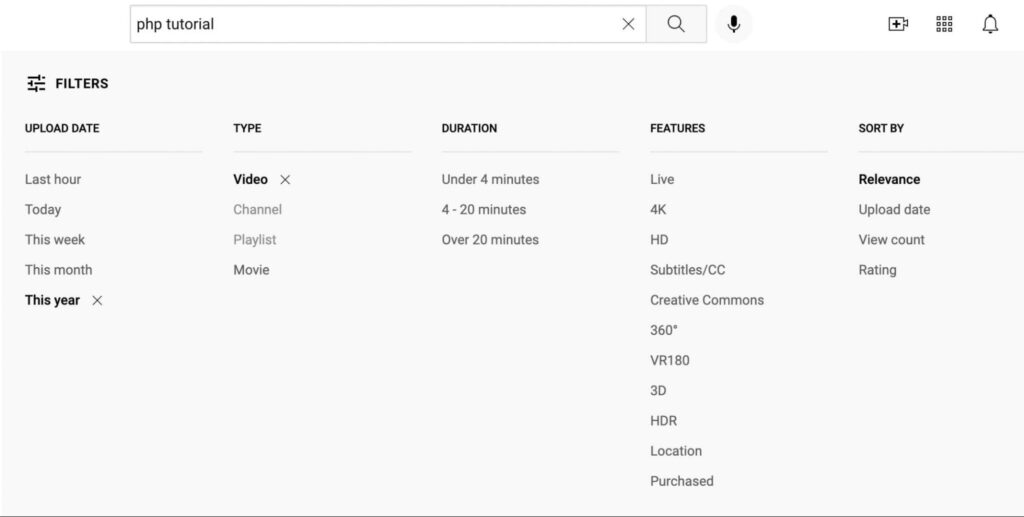
Then, you can find a video that suits your needs. One of the most popular PHP tutorials is PHP For Beginners by Traversy Media. This outlines the fundamentals of PHP:

In this YouTube video, you can use timestamps to skip to an area you want to learn. If you watch the entire three-hour tutorial, you can learn everything about PHP, including functions, loops, arrays, and more. By following along with the voiceover, you can create your first PHP/MySQL project.
You can also watch PHP Tutorial for Beginners – Full Course by Envato Tuts+. This is a more detailed PHP guide that takes you from an absolute beginner to an expert coder:

The instructor, Jeremy McPeak, starts with the basics, showing you everything you need to learn as a beginner. Then, he teaches you about variables, syntax, and how to make decisions in your code. By the end of the video, you’ll be able to write your own functions and respond to GET and POST requests.
When you search for PHP tutorials on YouTube, you can find thousands of free videos to watch. With this method, you can watch coding in real-time rather than reading a static web page.
2. Take an Online Course
If you want to receive a more in-depth explanation of PHP, you can sign up for an online course. Although it can take longer to complete course modules, this can lead to a more thorough education in programming.
Codecademy
Whether you’re trying to prepare for a career in web development or just learning programming languages as a hobby, you can learn how to code on Codecademy. This platform provides the free Learn PHP course, which has been taken by over 45 million people:

In 25 hours, you’ll receive a comprehensive overview of PHP, including variables, functions, arrays, loops, and more. Each module has instructions on how to immediately implement what you’ve learned:
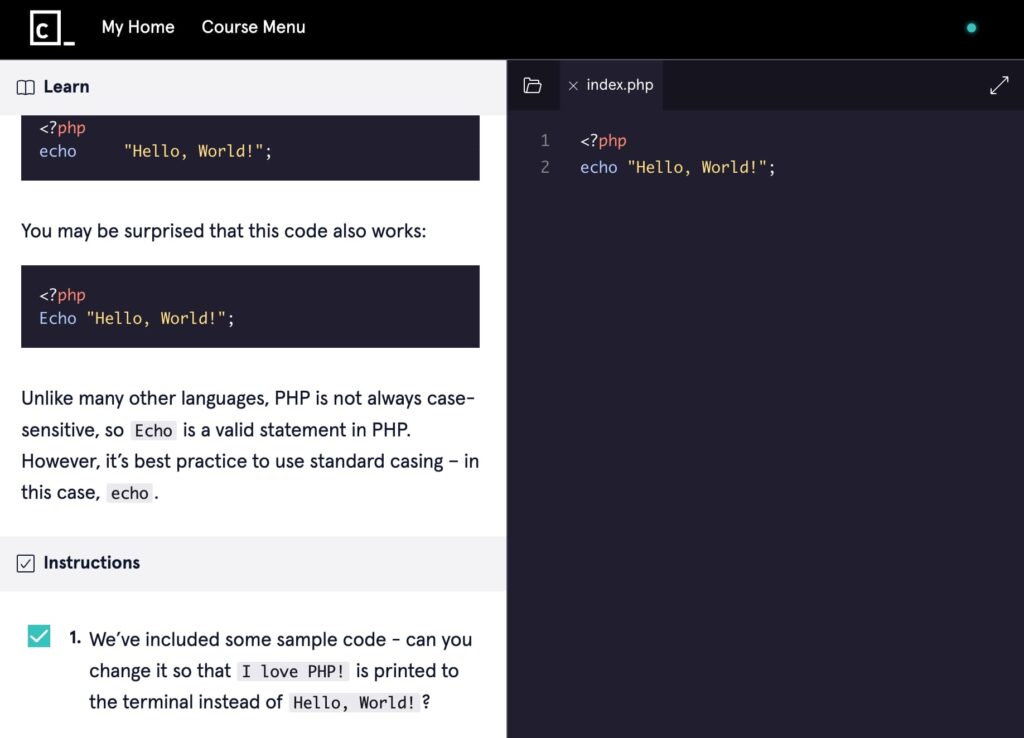
Once you follow the instructions and enter the correct coding, you can continue to the next lesson. If you need help, you can always use a hint:

At any point, you can review key concepts using the cheatsheet. You can also browse the Codecademy community forums for that module. These links are provided at the end of each exercise:

Since PHP interacts with HTML, you’ll likely need to know the basics of HTML before taking this course. Fortunately, Codecademy has a Learn HTML course that you can take beforehand.
Udemy
Another place to find PHP courses is Udemy. Here, you can join over six million users and start expanding your coding skills. Unlike Codecademy, Udemy contains many different PHP courses, so you can find the one that best suits your needs:

With over 22,000 reviews, the most popular PHP course on Udemy is called PHP for Beginners. In this program, you can watch 37 hours of educational videos and obtain a certificate once you’re finished:

If you’re completely new to coding, this Udemy course takes you through the basics of PHP, as well as Object Oriented PHP and MySQLi. You’ll learn about custom functions, PHP security, control structures, and much more. It also teaches you how to create a content management system similar to WordPress or Joomla.
3. Review the PHP Manual
You can also learn the best practices of the PHP language straight from the creators themselves. In the official PHP manual, you’ll gain installation instructions, syntax advice, and Frequently Asked Questions (FAQs) from other emerging developers.
When you first open the manual, you can read an overview of PHP and what it does. This will also list compatible operating systems and databases:
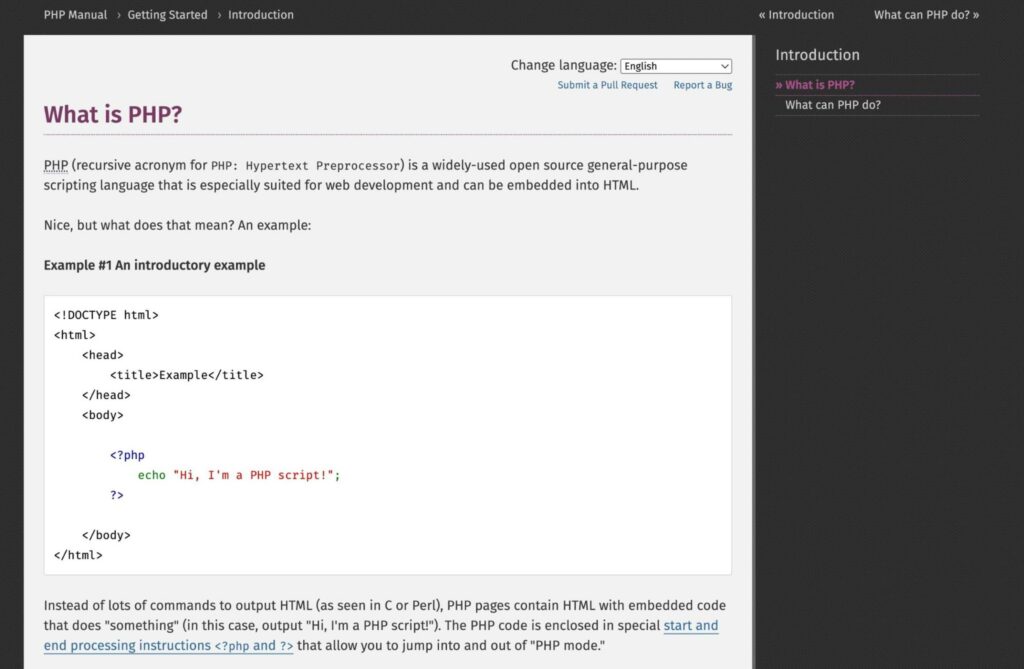
Then, you can follow the installation and configuration guide. Depending on your operating system, you’ll see some requirements and best practices on how to get started:

One of the most helpful sections of this manual is the Language Reference. Here, you’ll find a list of outbound links about basic PHP syntax and how to start writing your own code:

Similar to online courses, you can read how-to guides about variables, functions, operators, and much more. You’ll even learn how to handle PHP errors when they happen:

This manual also gives you information about PHP security. You can read about possible attacks, as well as error reporting:

As you become more knowledgeable in PHP, you can keep this manual for future reference. For example, you might need to look up certain functions to implement them properly:

However, the PHP manual may not be the best option for beginners. Although its information is valuable and straightforward, it doesn’t include any interactive exercises. You’re likely better off using this as a reference during the learning process.
4. Read a Book
If you’re a visual learner, one way to learn PHP is by reading a book. Whether you find an online publication or go to your local library, you can find valuable information about the PHP programming language.
PHP Apprentice is an online book that you can access for free. You can use this open-source reading material to start understanding PHP and its practices:
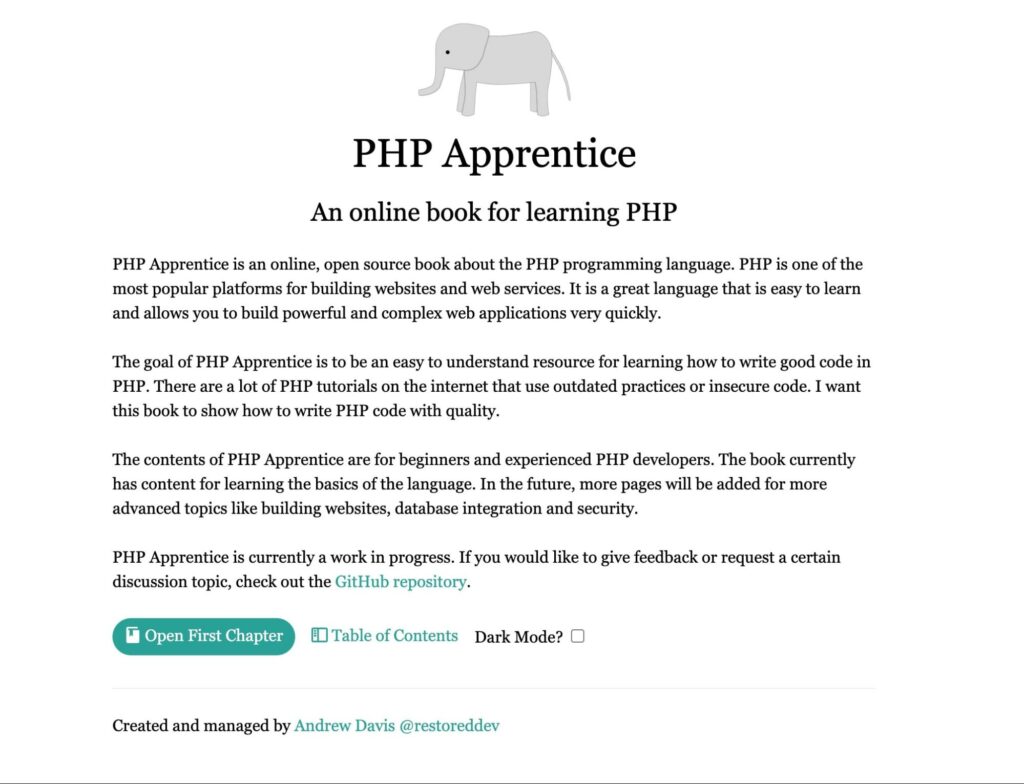
Using the table of contents, you can find a specific topic about PHP. For each chapter, there will be written explanations along with examples of coding:

Plus, PHP Apprentice is a book that is constantly evolving. By giving feedback on its GitHub repository, you can request certain topics or more in-depth explanations:

When learning a new skill like PHP, it can often be more convenient to read an e-book because they’re readily available online. However, you can also use your local library.
On your library’s website, you can search its database for PHP books. Then, you can place a hold on the ones you want to read:
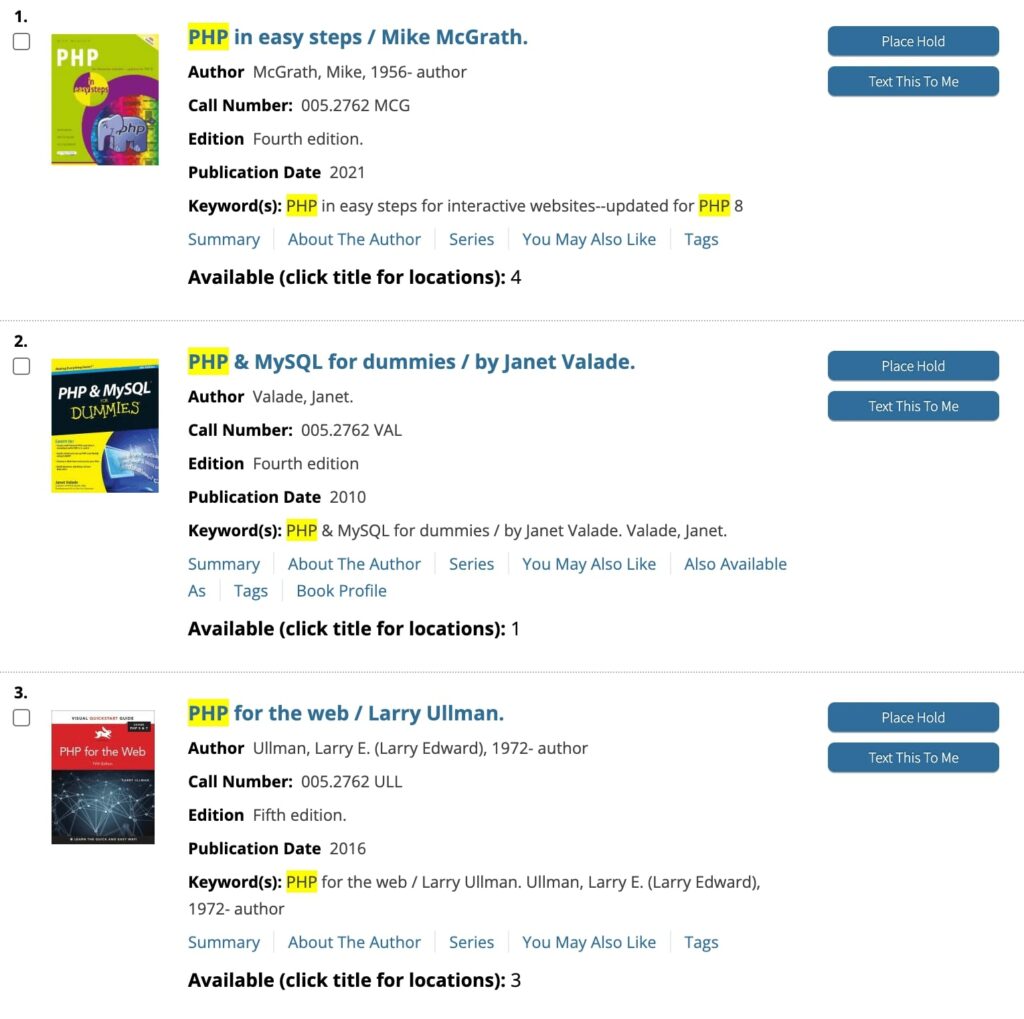
Some libraries even let you check out e-books using an app like CloudLibrary or OverDrive. This way, you can get your hands on library books without ever leaving your home.
Although the library can be a valuable resource for free books, you may not find the most up-to-date information. If you decide this method is right for you, you’ll want to look for books that were published in the last few years. This way, you’re not learning an outdated PHP version.
5. Try an Interactive Tutorial
Rather than signing up for an educational course in PHP, you can walk yourself through online tutorials. You don’t have to pay for the learning material or even create an account – you can simply open the website and start learning at your own pace. Let’s look at some options.
W3Schools
W3Schools is one of the best resources for free coding tutorials. On this platform, you can learn the basics of PHP, CSS, HTML, JavaScript, and much more.
When you click on its PHP guide, you’ll notice that there are tons of free modules to explore:

In the introductory sections, W3Schools will outline the basic concepts of PHP, as well as everything you need to get started:

When you dive into the learning modules, you can read detailed explanations about syntax, variables, operators, regular expressions, and any other PHP concept. You’ll also see coding examples on each page:

By clicking on Try it Yourself, you can open a code editor in a new tab. Here, you can implement changes to the existing code and see how it’ll look on the front end:
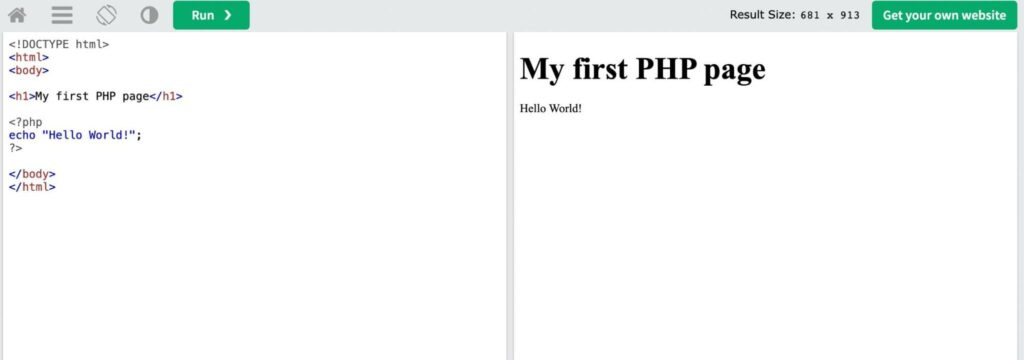
Once you grasp the basics, you can learn more advanced concepts. W3Schools will show you how to create forms with data validation. You’ll also learn how to use PHP with Object-Oriented Programming, a MySQL database, XML parsers, and AJAX.
When you feel comfortable with what you’ve learned, you can test your skills with quizzes and exercises:

This can help you remember what you’ve studied. Plus, you can check whether you need to revise certain concepts and go back to those modules if needed.
Learn-php.org
If you want to learn PHP with a simple but effective interface, you can try the interactive tutorial on learn-php.org. Although this won’t turn you into a developer, you can use it to understand how PHP works:
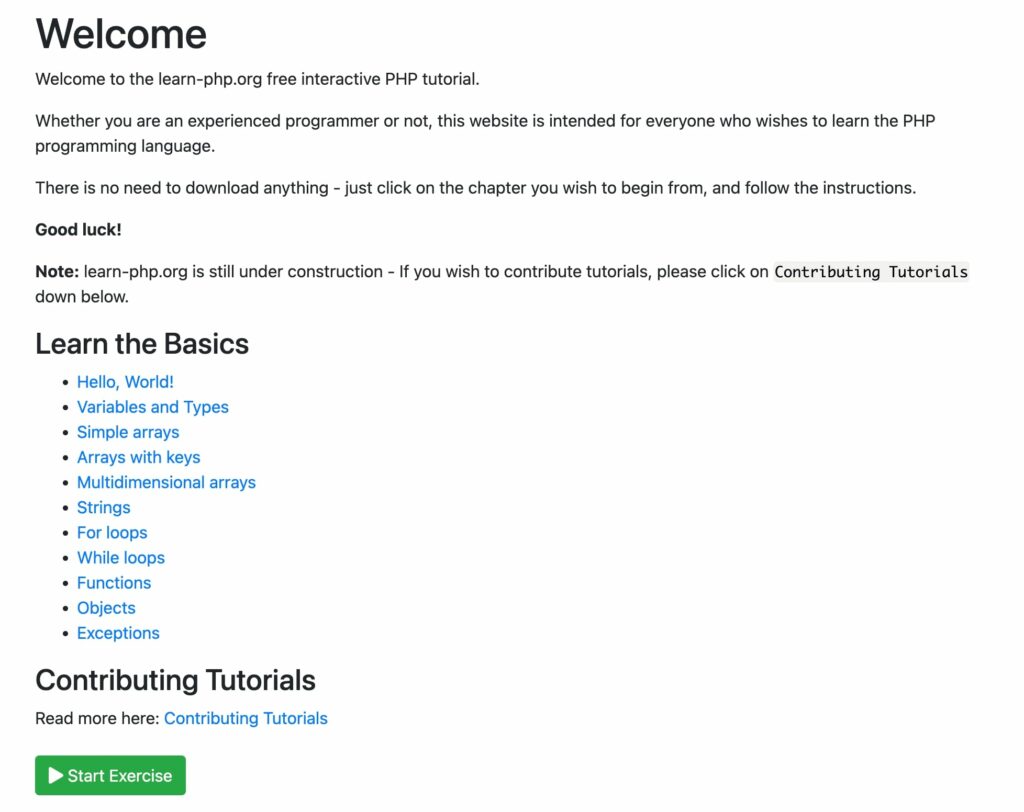
In just 11 modules, you’ll learn about variables, arrays, strings, loops, functions, and more. Like some other options on this list, learn-php.org includes simple explanations of concepts, followed by coding examples:

At the bottom of the page, you can perform an exercise to test your knowledge. For example, you may have to create a new array in PHP:
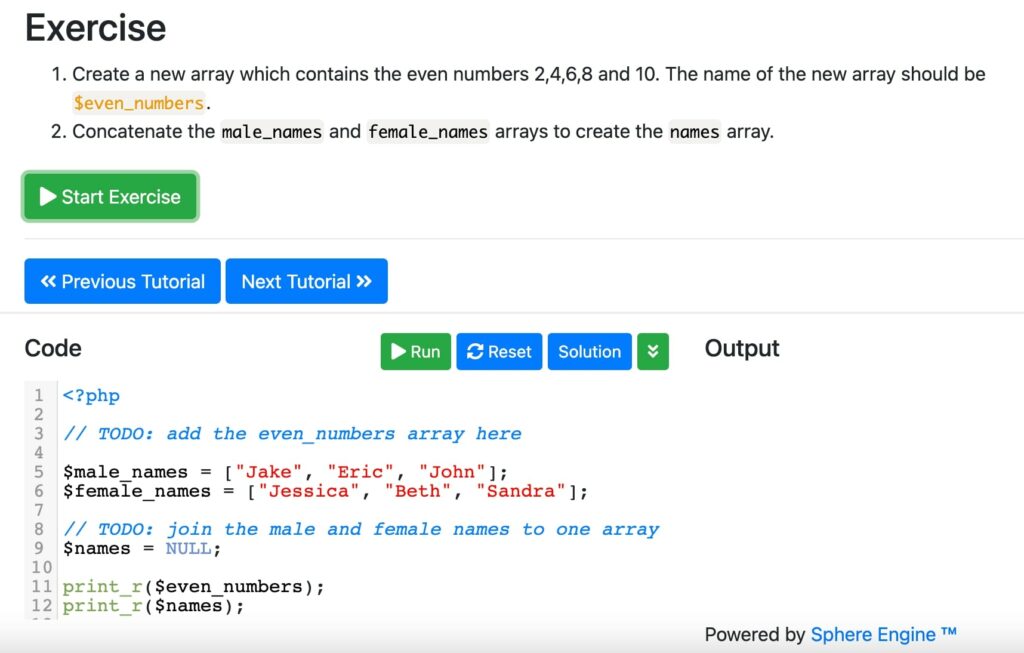
Although learn-php.org doesn’t have a lot of modules yet, it is constantly being updated. Using its GitHub repository, developers can add new tutorials for you to learn for free.
Start Learning PHP Today
By learning the basics of PHP, you can jumpstart your career in web development. Since PHP is a vital part of WordPress, this skill can help you create new themes and plugins for personal or public use.
Here are some ways you can start learning PHP as a beginner:
- Watch a YouTube tutorial from creators such as Traversy Media and Envato Tuts+.
- Take an online course on Codecademy or Udemy.
- Review the PHP manual.
- Read a book like PHP Apprentice.
- Try an interactive tutorial on W3Schools or learn-php.org.
If you want to start experimenting with PHP, you may want to create your own website. With our shared hosting plans, you can quickly launch a new site without breaking the bank!

Web Hosting That Powers Your Purpose
We make sure your website is fast, secure and always up so your visitors trust you. Plans start at $1.99/mo.
Choose Your Plan
